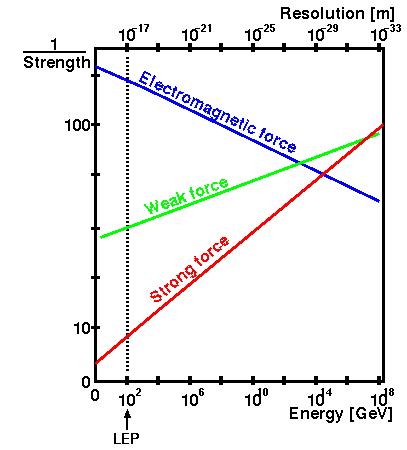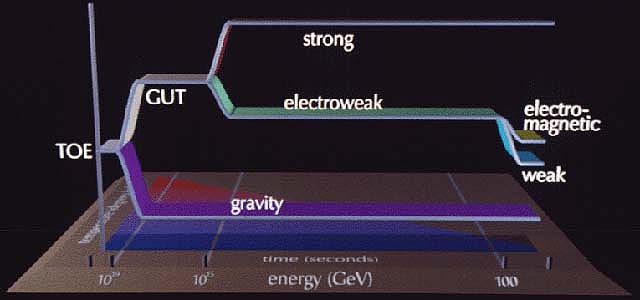
The running coupling constants.
So we have learned that the coupling constants of the interactions of nature are hugely different. It is this difference that governs the behaviour of the Universe today. Gravity governs the large scale behaviour, acting gently between all the mass in the Universe. It keeps the planets of our solar system in orbit around the Sun. The electromegnetic interaction keeps electrons in orbit around atomic nuclei, and governs the behaviour of matter at atomic and molecular scales. The strong and weak interactions govern the behaviour of matter at even smaller, nuclear and sub-nuclear, scales.
It may seem surprising, but despite the huge differences in the strength of the interactions, physicists believe that they are all part of the same phenomenon. It is the ultimate goal of modern physics to find a single theoretical framework to describe them all. One important clue that they might all be the same comes from the fact that the coupling constants are not constants at all. Instead, they vary with the energy of the phenomenon in which they are measured. The value of as quoted above is only true for phenomena that occur at around 91 GeV of energy, the mass of the Z particle. Similarly, the coupling constant for the electromagnetic interaction has been measured to be about 1/137 in studies of atomic phenomena. When it is measured at the higher energies of LEP, however, its value has increased to about 1/128! The value of the coupling constant is said to 'run' with energy, and the constants themselves are usually referred to as running coupling constants.

The running coupling constants.
Scientists believe that as they push the energy they are able to study higher and higher (achieving smaller and smaller resolution), they will see the values of the coupling constants get closer and closer together. They believe that at the energy that was around at the Big Bang, all the interactions would have had the same strength with the individual interactions familiar to us condensing out as the Universe expanded and cooled. This idea is called unification of interactions.
It might seem like a far fetched idea, but there has already been some success on the road to unification. In the latter half of the 19th century, Maxwell unified the apparently different phenomena of electricity and magnetism. Then in the 1970s, physicists managed to work out a theoretical framework for unifying electromagnetism and the weak interaction.

The ultimate theory would describe the single primitive interaction out of which the Universe was born.